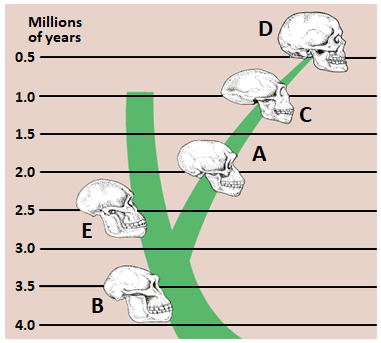Select Question Set:
The frequencies of dominant and recessive alleles of a gene in a population are 0.7 and 0.3 respectively. The expected frequency for heterozygotes in the population is likely to be:
1. 42%
2. 49%
3. 21%
4. 9%
Subtopic: Hardy Weinberg Law |
83%
From NCERT
Please attempt this question first.
Hints
Please attempt this question first.
Identify the correct statement:
| 1. | Evolution by natural selection works best on a population having no variation. |
| 2. | Mutation is a relatively unimportant source of variation and is not the foundation for evolution. |
| 3. | The effects of genetic drift are most apparent in small populations. |
| 4. | Inbreeding increases the proportion of heterozygous individuals in a population. |
Subtopic: Difference Between Drift & Selection | Hardy Weinberg Law |
79%
From NCERT
Please attempt this question first.
Hints
Please attempt this question first.
Embryological support for evolution was proposed by:
1. Ernst Mayr
2. Ernst Haeckel
3. Hugo de Vries
4. Kary Mullis
Subtopic: Embryological Evidence of Evolution |
84%
From NCERT
Please attempt this question first.
Hints
Please attempt this question first.
A process in which heritable variations enabling better survival are enabled to reproduce and leave greater number of progeny is called:
1. Evolution
2. Saltation
3. Speciation
4. Natural selection
1. Evolution
2. Saltation
3. Speciation
4. Natural selection
Subtopic: Hardy Weinberg Law |
78%
From NCERT
Please attempt this question first.
Hints
Please attempt this question first.
In 1953, S.L. Miller created conditions similar to those suggested by Oparin and Haldane in a laboratory where he created electric discharge in a closed flask containing:
| 1. | CH4, H2, NH3 and water vapour at 800°C |
| 2. | CH4, H2, HCN and hydrogen sulphide at 400°C |
| 3. | CO2, H2, NH3 and water vapour at 800°C |
| 4. | CO2, H2, HCN and hydrogen sulphide at 400°C |
Subtopic: Urey & Miller Experiment |
94%
From NCERT
Please attempt this question first.
Hints
Please attempt this question first.
Darwin’s finches represent one of the best examples of:
1. Saltation
2. Sympatric speciation
3. Adaptive radiation
4. Convergent evolution
1. Saltation
2. Sympatric speciation
3. Adaptive radiation
4. Convergent evolution
Subtopic: Additional Theories of Darwin | Concept of Organic Evolution: Evidence |
94%
From NCERT
Please attempt this question first.
Hints
Please attempt this question first.
Populations at genetic equilibrium [Hardy Weinberg equilibrium]:
1. are very small
2. are not experiencing any natural selection
3. have individuals frequently going out and coming in
4. are mating randomly
Subtopic: Hardy Weinberg Law |
62%
Please attempt this question first.
Hints
Adaptations for evolutionary significance:
| 1. | develop throughout the lifetime of organisms and are then passed on to their offspring |
| 2. | develop after a population encounters a change in environment |
| 3. | are inherited characteristics |
| 4. | decrease the chances of the organism surviving until maturity |
Subtopic: Concept of Organic Evolution: Evidence |
Please attempt this question first.
Hints
Working independently, who reached conclusions similar to those reached by Darwin on evolution of life forms?
1. T R Malthus
2. Hugo de Vries
3. Alfred Russell Wallace
4. Jean Baptist Lamarck
1. T R Malthus
2. Hugo de Vries
3. Alfred Russell Wallace
4. Jean Baptist Lamarck
Subtopic: Theory of Evolution & Lamarckism | Darwin's Theory |
71%
From NCERT
Please attempt this question first.
Hints
Please attempt this question first.
The diagram shows a possible family tree for humans. If D is Homo sapiens, what can be A and C respectively?

1. Ramapithecus and Sivapithecus
2. Sivapithecus and Ramapithecus
3. Homo habilis and Homo erectus
4. Homo erectus and Homo habilis

1. Ramapithecus and Sivapithecus
2. Sivapithecus and Ramapithecus
3. Homo habilis and Homo erectus
4. Homo erectus and Homo habilis
Subtopic: Introduction to Human Evolution | Evolution of Homo Sapiens |
82%
From NCERT
Please attempt this question first.
Hints
Please attempt this question first.






